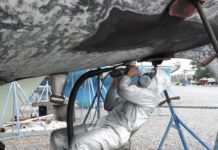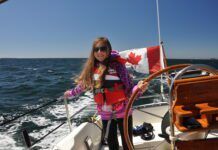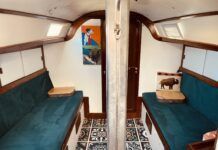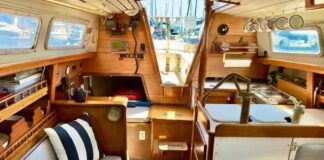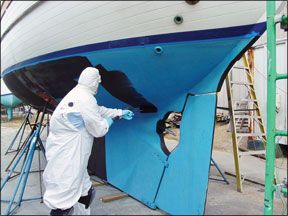
288
In addition to our annual paint-panel tests, Practical Sailor has a host of ongoing head-to-head field tests of the top-performing antifouling paints. Our test-boat fleet allows us to evaluate paints in real-world conditions on boats that run the gamut in terms of usage, storage, and cruising grounds.
For the head-to-head tests, each boat’s hull below the waterline is divided into four equal sections (two per side). One paint is applied to the port bow and starboard aft section, while another is painted onto the starboard bow and port after section, giving both paints equal exposure. Paints are applied following maker’s instructions, and an extra coat is applied at the waterline.
Off With The Old…
In our last test-boat checkup (March 2008), we reported on Practical Sailor’s 21-foot Parker 2110 powerboat head-to-head test, which pitted an inexpensive one-season, sloughing coating (Interlux Tarr & Wonson) against a pricey, multi-season paint that releases its copper at a controlled rate (Interlux Micron 66). We found Tarr & Wonson for $79 (www.jamestowndistributors.com), and Micron 66 for $220 (www.jamestowndistributors.com).
At 17 months, the Tarr & Wonson had lost its punch, allowing barnacles at the waterline, while the Micron 66 was free of hard growth. After two years, however, both paints had barnacles. The Micron 66 allowed only a sprinkling of barnacles on the port side. The Tarr & Wonson-covered port section gave up more barnacles. Both paints began having adhesion problems as well. As expected, the Micron 66 won this long war.
Practical Sailor spent no less than 10 hours prepping the Parker for its next round of antifoulant testing. We used chemicals, scrapers, and a power sander to remove the stubborn hard growth.
This time, we matched up Blue Water Kolor and Micron 66. Like Micron 66, Kolor is an expensive, multi-season coating that falls into the ablative/copolymer category. (We found Kolor for $162 a gallon at www.ship2shoremarine.com.) Kolor and Micron 66 contain similar amounts of copper too: 45 and 40 percent, respectively.
Kolor comes in bright colors and uses cuprous thicyanate, which doesn’t dull the color like cuprous oxide does.
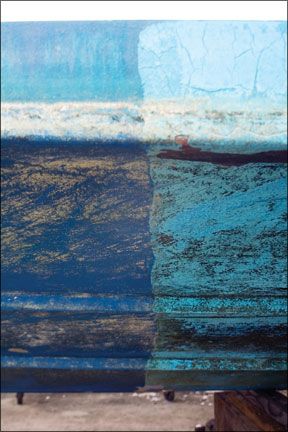
288
Micron 66 took about twice as long to apply as the Kolor, which rolled on easily and dried quickly. We used Seafit 4-inch mini rollers to apply each paint. Both manufacturers said the Parker’s bare spots would benefit from a primer coating.
Practical Sailor splashed the Parker in early September. Look for an update in early 2009.
Water-Based Paints
In March, Practical Sailor testers hauled out and repainted another test boat, a 36-foot, full-keel Union Cutter out of Chesapeake Bay. The Union was previously the platform for an Interlux Micron Optima vs. Sea Hawk Monterey antifouling test (March 2008). However, Interlux has since pulled the plug on the two-part Micron Optima, so we did the same for the test.
Both the Optima and Monterey, a single-season ablative—applied in summer 2006—were found to be in good shape when the boat was hauled. Only a light sanding was needed to prepare the hull for repainting.
As with any paint application where existing coats are not stripped completely, we confirmed with the makers that the new paints—Flexdel Aquagard and Pettit Hydrocoat—were compatible with the previous coatings.
Hydrocoat and Aquagard are water-based, “hard” ablative paints that can be hauled and re-launched multiple times without loss of effectiveness. We found both for $105 at www.defender.com.
Flexdel’s Aquagard releases low levels of volatile organic compounds (VOC) and heavy metals compared to other competing products. It is designed for use on wood and fiberglass boats. It was applied to the port bow and starboard aft sections of our test boat. It went on very smoothly, had little odor, and was easily cleaned up with soap and water.
Hydrocoat is thinner, but it has little odor and went on easily. It was applied to the starboard bow and port after sections. Pettit claims the coating withstands frequent trailering, beaching, and launching without loss of protection.
Six months after the application—the boat was kept at a dock off the Chesapeake—the entire hull was coated with a thick layer of slime that was easily dispersed with a wave of the hand (underwater). The thickness of the slime coating was uniform, with no noticeable difference between the different paints. No hard growth was noted.
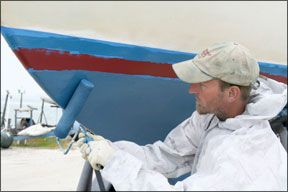
288
Stay tuned for updates on how well they’re faring as our test boat cruises the Chesapeake and Intracoastal Waterway.
Underneath It All
A third Practical Sailor test boat, a 41-foot Ericson homeported in Annapolis, Md., was the platform for a test of two barrier-coat systems, Interlux InterProtect 2000E and Sherwin Williams Sea Guard. Both epoxy-based products, they were applied in July 2008 over a cleanly stripped and sanded bottom.
Four coats of barrier coat were rolled on using solvent-resistant foam rollers and vertical strokes. A chemical bond was maintained, no between-coat sanding was necessary, and each of the four layers was applied as soon as the previous coat was ready to overcoat. (Look for the full report in an upcoming issue.)
Interlux Micron 66 was chosen as the bottom paint. All three coats were applied with a foam roller using Interlux’s recommendations for a “no-sand” chemical bond. This was accomplished by carefully monitoring the coats as they dried, and waiting to overcoat until the paint on the masking tape at the waterline could be touched leaving a fingerprint in the paint but no residue on the finger. (If paint sticks to the finger, it’s too early to overcoat.)
The Ericson is kept at a dock in a creek on Upper Chesapeake Bay. No growth was reported on its hull at press time, two months after application.
Spicy Experiment
In November 2007, we enlisted one of our test boats, a Cape Dory 25 in Sarasota, Fla., to find out whether there is any validity to the old salt’s tale that adding cayenne pepper to bottom paint increases its antifouling ability. Now, nearly a year later, we can call this myth busted.
The Cape Dory—daysailed several times a week, cruised occasionally, and kept on a mooring in the warm waters of Sarasota Bay—was a prime test platform for the experiment. Testers applied Interlux Bottomkote alone to the boat’s port bow and starboard after sections. Bottomkote mixed with a large amount of cayenne pepper was applied to the boat’s starboard bow and aft port quarters. The bottom was cleaned in the water every three to six weeks and was hauled for a serious scrubbing in late April 2008.
After 10 months, testers noted no difference in growth between the sections with and without cayenne. There was an even distribution of some hard growth and considerable soft growth.
One notable drawback to adding pepper to your bottom paint is the bumpy texture. A spicy bottom, it seems, can be a drag.


















